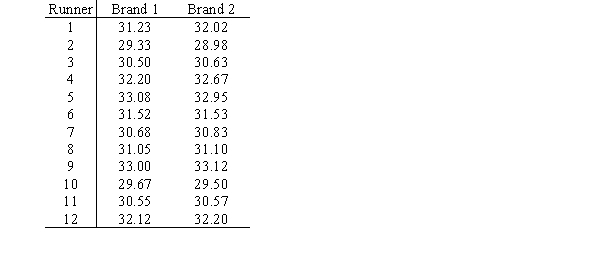Twelve runners are asked to run a 10-kilometer race on each of two consecutive weeks.In one of the races,the runners wear one brand of shoe and in the other,a different brand.The brand of shoe they wear in each race is determined at random.All runners are timed and are asked to run their best in each race.The results (in minutes) are given below.  Use the sign test for matched pairs to determine if there is evidence that times using Brand 1 tend to be faster than times using Brand 2.Determine which of the following statements is TRUE.
Use the sign test for matched pairs to determine if there is evidence that times using Brand 1 tend to be faster than times using Brand 2.Determine which of the following statements is TRUE.
A) We would not reject the null hypothesis of no difference at the 0.10 level.
B) We would reject the null hypothesis of no difference at the 0.10 level but not at the 0.05 level.
C) We would reject the null hypothesis of no difference at the 0.05 level but not at the 0.01 level.
D) We would reject the null hypothesis of no difference at the 0.01 level.
Correct Answer:
Verified
Q29: A study was conducted to determine
Q30: Do students tend to improve their
Q31: A study was to be undertaken
Q32: A study was to be undertaken
Q33: A one-sample t test of H0:
Q35: A study was to be undertaken
Q36: A random sample of 20 observations produced
Q37: Twelve runners are asked to run a
Q38: Twelve runners are asked to run
Q39: Do students tend to improve their
Unlock this Answer For Free Now!
View this answer and more for free by performing one of the following actions

Scan the QR code to install the App and get 2 free unlocks

Unlock quizzes for free by uploading documents